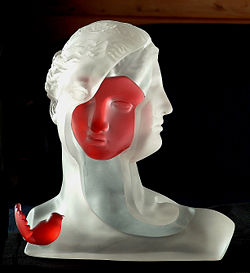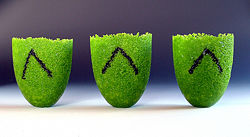
Glass casting
Encyclopedia

Glass
Glass is an amorphous solid material. Glasses are typically brittle and optically transparent.The most familiar type of glass, used for centuries in windows and drinking vessels, is soda-lime glass, composed of about 75% silica plus Na2O, CaO, and several minor additives...
objects are cast
Casting
In metalworking, casting involves pouring liquid metal into a mold, which contains a hollow cavity of the desired shape, and then allowing it to cool and solidify. The solidified part is also known as a casting, which is ejected or broken out of the mold to complete the process...
by directing molten glass into a mould
Molding (process)
Molding or moulding is the process of manufacturing by shaping pliable raw material using a rigid frame or model called a pattern....
where it solidifies. The technique has been used since the Egyptian
Ancient Egypt
Ancient Egypt was an ancient civilization of Northeastern Africa, concentrated along the lower reaches of the Nile River in what is now the modern country of Egypt. Egyptian civilization coalesced around 3150 BC with the political unification of Upper and Lower Egypt under the first pharaoh...
period. Modern cast glass is formed by a variety of processes such as kiln casting, or casting into sand, graphite or metal moulds.
Roman period
During the Roman periodRoman Empire
The Roman Empire was the post-Republican period of the ancient Roman civilization, characterised by an autocratic form of government and large territorial holdings in Europe and around the Mediterranean....
moulds consisting of two or more interlocking parts were used to create blank glass dishes. Glass could be added to the mould either by frit casting, where the mould was filled with chips of glass (called frit
Frit
Frit is a ceramic composition that has been fused in a special fusing oven, quenched to form a glass, and granulated. Frits form an important part of the batches used in compounding enamels and ceramic glazes; the purpose of this pre-fusion is to render any soluble and/or toxic components insoluble...
) and then heated to melt the glass, or by pouring molten glass into the mould. Evidence from Pompeii
Pompeii
The city of Pompeii is a partially buried Roman town-city near modern Naples in the Italian region of Campania, in the territory of the comune of Pompei. Along with Herculaneum, Pompeii was destroyed and completely buried during a long catastrophic eruption of the volcano Mount Vesuvius spanning...
suggests that molten hot glass may have been introduced as early as the mid-1st century CE
Common Era
Common Era ,abbreviated as CE, is an alternative designation for the calendar era originally introduced by Dionysius Exiguus in the 6th century, traditionally identified with Anno Domini .Dates before the year 1 CE are indicated by the usage of BCE, short for Before the Common Era Common Era...
. Blank vessels were then annealed
Annealing (glass)
Annealing is a process of slowly cooling glass to relieve internal stresses after it was formed. The process may be carried out in a temperature-controlled kiln known as a Lehr. Glass which has not been annealed is liable to crack or shatter when subjected to a relatively small temperature change...
, fixed to lathe
Lathe
A lathe is a machine tool which rotates the workpiece on its axis to perform various operations such as cutting, sanding, knurling, drilling, or deformation with tools that are applied to the workpiece to create an object which has symmetry about an axis of rotation.Lathes are used in woodturning,...
s and cut and polished on all surfaces to achieve their final shape. Pliny the Elder
Pliny the Elder
Gaius Plinius Secundus , better known as Pliny the Elder, was a Roman author, naturalist, and natural philosopher, as well as naval and army commander of the early Roman Empire, and personal friend of the emperor Vespasian...
indicates in his Natural History (36.193) that lathes were used in the production of most glass of the mid-1st century.
Italy is believed to have been the source of the majority of early Imperial
Roman Empire
The Roman Empire was the post-Republican period of the ancient Roman civilization, characterised by an autocratic form of government and large territorial holdings in Europe and around the Mediterranean....
polychrome cast glass, whereas monochrome cast glasses are more predominant elsewhere in the Mediterranean
Mediterranean Basin
In biogeography, the Mediterranean Basin refers to the lands around the Mediterranean Sea that have a Mediterranean climate, with mild, rainy winters and hot, dry summers, which supports characteristic Mediterranean forests, woodlands, and scrub vegetation...
. Forms produced show clear inspiration from the Roman bronze
Bronze
Bronze is a metal alloy consisting primarily of copper, usually with tin as the main additive. It is hard and brittle, and it was particularly significant in antiquity, so much so that the Bronze Age was named after the metal...
and silver
Silver
Silver is a metallic chemical element with the chemical symbol Ag and atomic number 47. A soft, white, lustrous transition metal, it has the highest electrical conductivity of any element and the highest thermal conductivity of any metal...
industries, and in the case of carinated bowls and dishes, from the ceramic industry. Cast vessel forms became more limited during the late 1st century, but continued in production into the second or third decade of the 2nd century. Colourless cast bowls were widespread throughout the Roman world in the late 1st and early 2nd century CE, and may have been produced at more than one centre. Some revival of the casting technique appears in the third or 4th century, but appears to have produced relatively small numbers of vessels
Sand casting
Sand castingSand casting
Sand casting, also known as sand molded casting, is a metal casting process characterized by using sand as the mold material.It is relatively cheap and sufficiently refractory even for steel foundry use. A suitable bonding agent is mixed or occurs with the sand...
involves the use of hot molten glass poured directly into a preformed mould. It is a process similar to casting metal into a mould. The sand mould is typically prepared by using a mixture of clean sand and a small proportion of the water-absorbing clay bentonite
Bentonite
Bentonite is an absorbent aluminium phyllosilicate, essentially impure clay consisting mostly of montmorillonite. There are different types of bentonite, each named after the respective dominant element, such as potassium , sodium , calcium , and aluminum . Experts debate a number of nomenclatorial...
. Bentonite acts as a binding material. In the process, a small amount of water is added to the sand-bentonite mixture and this is well mixed and sifted before addition to an open topped container. A template is prepared (typically made of wood, or a found object or even a body part such as a hand or fist) which is tightly pressed into the sand to make a clean impression. This impression then forms the mould.
The surface of the mould can be covered in coloured glass powders or frits to give a surface colour to the sand cast glass object. When the mould preparation is complete hot glass is ladled from the furnace at temperatures of about 1200 C to allow it to freely pour. The hot glass is poured directly into the mould. During the pouring process, glass or compatible objects may be placed to later give the appearance of floating in the solid glass object. This very immediate and dynamic method was pioneered and perfected in the 1980s by the Swedish artist Bertil Vallien.
Kiln casting
Kiln casting involves the preparation of a mould which is often made of plaster or plaster mixtures. A model can be made of any solid material such as wax, wood or metal and after taking a cast of the model, (a process called investment), the model is removed from the mould. One method of forming a mould is by the Cire perdue or "lost wax" method. Using this, a model can be made from wax and after investment the wax can be steamed or burned away in a kiln. The heat resistant mould is then placed in a kiln with a funnel like refractoryRefractory
A refractory material is one that retains its strength at high temperatures. ASTM C71 defines refractories as "non-metallic materials having those chemical and physical properties that make them applicable for structures, or as components of systems, that are exposed to environments above...
opening which is filled with solid glass granules or lumps. The kiln is heated to a high temperature, normally between 800 and 1000 degrees Celsius, and as the glass melts it runs, settling into and filling the mould.
Such kiln cast work could be made of very large proportions and was famously brought to a zenith in the glass art world by the famous works of the Czechoslovakia
Czechoslovakia
Czechoslovakia or Czecho-Slovakia was a sovereign state in Central Europe which existed from October 1918, when it declared its independence from the Austro-Hungarian Empire, until 1992...
n masters Stanislav Libensky and Jaroslava Brychtova. Kiln cast glass has become an important material for contemporary artists and has been brought to new zeniths, as can be seen in the works of Karen LaMonte
Karen LaMonte
Karen LaMonte is an American artist known for her life-size sculptures in ceramic, bronze and cast glass as well as her large scale monotype prints.-Background:...
.
Pâte de verre

Gum arabic
220px|thumb|right|Acacia gumGum arabic, also known as acacia gum, chaar gund, char goond, or meska, is a natural gum made of hardened sap taken from two species of the acacia tree; Acacia senegal and Acacia seyal...
and water, and often with colourants and enamel
Vitreous enamel
Vitreous enamel, also porcelain enamel in U.S. English, is a material made by fusing powdered glass to a substrate by firing, usually between 750 and 850 °C...
s. The resultant paste is applied to the inner surface of a negative mould forming a coating. After the coated mould is fired at the appropriate temperature the glass is fused creating a hollow object that can have thick or thin walls depending on the thickness of the pate de verre layers. Daum, a French commercial crystal manufacturer, produce highly sculptural pieces in pate de verre.
Graphite Casting
GraphiteGraphite
The mineral graphite is one of the allotropes of carbon. It was named by Abraham Gottlob Werner in 1789 from the Ancient Greek γράφω , "to draw/write", for its use in pencils, where it is commonly called lead . Unlike diamond , graphite is an electrical conductor, a semimetal...
is also used in the hot forming of glass. Graphite moulds are prepared by carving into them, machining them into curved forms or by stacking them into shapes. Molten glass is poured into the moulds then cooled until hard enough to be removed and placed into an annealing kiln to cool slowly.

